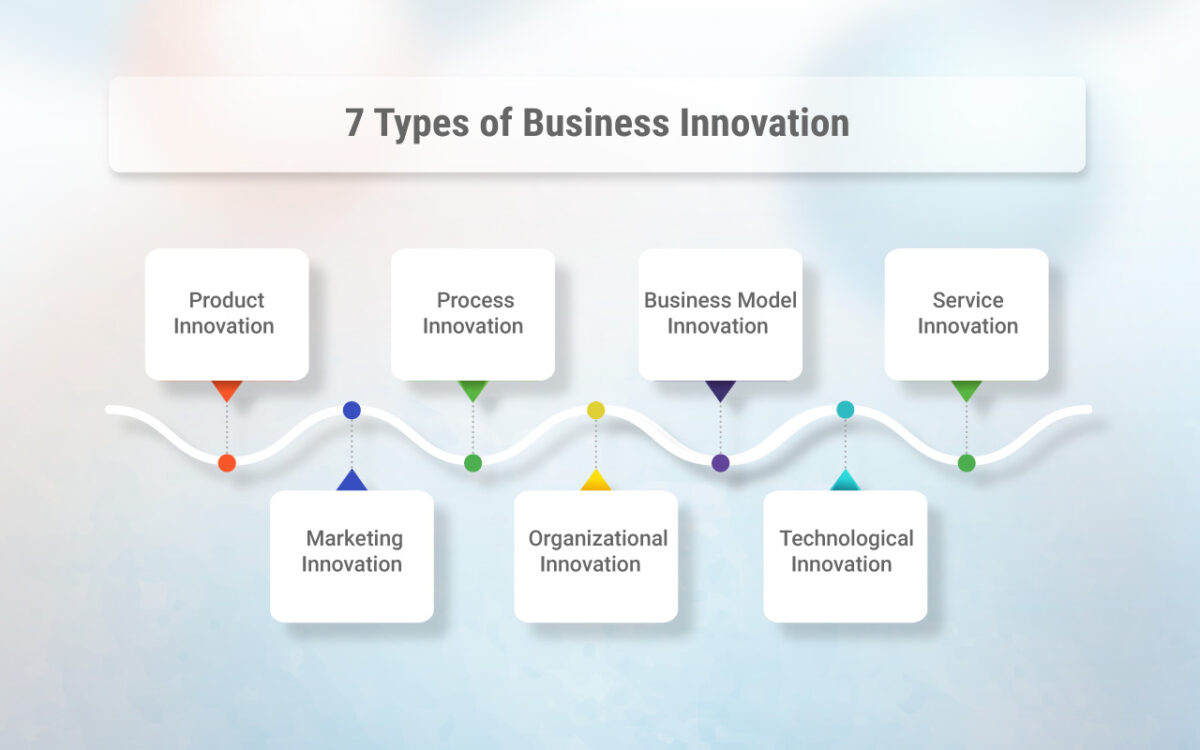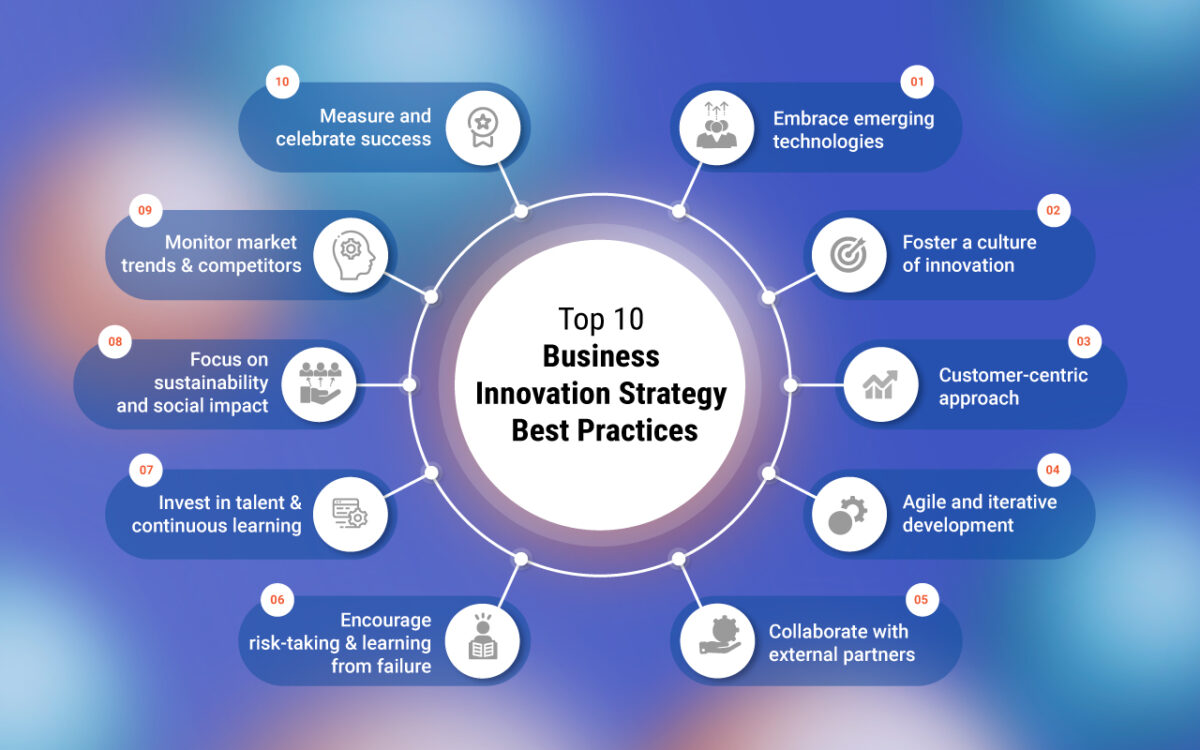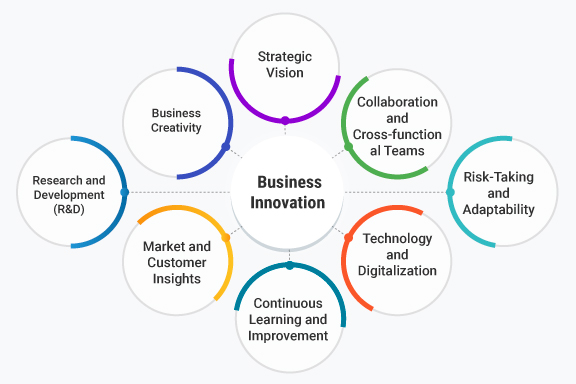What is Business Innovation?
Business innovation is the process of introducing new ideas, workflows, products, services, or business models that enhance a company’s value, improve efficiency, and support strategic growth. At its core, innovation is about finding better ways to solve problems, meet customer needs, and stay ahead of the competition.
Business innovation can take many forms—from launching breakthrough products to optimizing existing operations or creating entirely new ways of delivering value. Whether it’s developing a cutting-edge technology or streamlining internal processes, the goal is the same: to generate measurable improvements and drive sustainable success.
Key Elements of Business Innovation
To build a culture of innovation, companies must focus on several key drivers:
- Creativity and Idea Generation: Innovation starts with fresh thinking. Encourage brainstorming and challenge conventional wisdom to uncover bold new ideas.
- Research & Development (R&D): R&D turns ideas into real-world solutions. Investing in R&D helps develop new products, processes, and technology innovations that keep your business ahead of the curve.
- Customer and Market Insights: Innovation must be relevant. Use customer feedback, trend analysis, and data to uncover unmet needs and opportunities.
- Cross-functional Collaboration: Break down silos. Innovation thrives when diverse teams work together and bring multiple perspectives to the table.
- Risk-taking and Adaptability: Innovation involves uncertainty. Cultivate a mindset that embraces experimentation, learns from failure, and adapts quickly.
- Technology and Digital Transformation: Leverage AI, IoT, blockchain, and other technologies to drive both incremental and disruptive innovation.
- Strategic Alignment: Link innovation initiatives to broader business goals. A clear innovation strategy helps prioritize the right projects and allocate resources effectively.
- Continuous Learning: Innovation is never “done.” Use feedback loops and performance metrics to refine ideas, improve implementation, and keep evolving.
Why Business Innovation Matters
In today’s fast-changing market, business innovation is no longer optional—it’s essential. It can:
- Improve customer satisfaction through better solutions
- Increase revenue and reduce operational costs
- Enable faster decision-making and adaptability
- Differentiate a brand in crowded markets
- Fuel long-term growth and resilience
Examples of Business Innovation
- Tesla revolutionized transportation by making electric vehicles mainstream.
- Dyson reinvented the household vacuum using cyclone technology.
- Uber and Zipcar transformed mobility through service innovation.
7 Types of Business Innovation

There are 7 key types of business innovation, each focusing on different aspects of an organization. Here they are:
1. Product Innovation: Product innovation involves creating or improving products or services. It may include introducing new features, enhancing performance, improving quality, or developing entirely new offerings to meet customer needs and preferences.
2. Process Innovation: Process innovation focuses on improving the efficiency, effectiveness, or sustainability of internal business operations. It involves reimagining and optimizing workflows, implementing new technologies, streamlining processes, and eliminating bottlenecks to enhance productivity, reduce costs, or minimize waste.
3. Business Model Innovation: Business model innovation refers to creating or redesigning the fundamental way a company creates, delivers, and captures value. It involves rethinking revenue streams, cost structures, distribution channels, customer relationships, or the overall value proposition to gain a competitive edge in the market.
4. Service Innovation: Service innovation entails developing new or improved services to better meet customer needs or enhance the customer experience. It may involve offering additional services, personalization, customization, or finding innovative ways to deliver services through digital platforms.
5. Marketing Innovation: Marketing innovation focuses on finding creative and effective ways to promote products or services, reach target audiences, and engage customers. It may involve adopting new marketing channels, utilizing social media strategies, implementing influencer marketing, or developing innovative advertising campaigns.
6. Organizational Innovation: Organizational innovation involves redesigning the internal structure, processes, or management practices of an organization. It may include adopting new decision-making models, implementing agile methodologies, fostering a culture of innovation, or promoting collaboration and knowledge sharing across teams.
7. Technological Innovation: Technological innovation refers to the development or adoption of new technologies to drive business growth and transformation. It may involve leveraging emerging technologies, such as artificial intelligence, machine learning, blockchain, augmented reality, or the Internet of Things (IoT), to enhance products, services, or operations.
It’s important to note that these types of innovation are not mutually exclusive, and organizations often engage in multiple types simultaneously or sequentially to stay competitive and adapt to changing market conditions.
Learn more: What is Innovation Management?
Business Innovation Strategy Process: 9 Key Steps
The business innovation strategy process involves a series of steps to guide organizations in developing and implementing innovative initiatives. Here are the key steps involved:
Step 1. Set Objectives
Begin by clearly defining the objectives of the innovation strategy. This involves identifying the desired outcomes, such as entering new markets, improving customer experience, increasing operational efficiency, or fostering a culture of innovation within the organization. The objectives should align with the overall business strategy.
Step 2. Assess Current State
Evaluate the organization’s current capabilities, strengths, weaknesses, and market position. This assessment helps identify areas where innovation can have the most significant impact and areas that may require improvement or investment to support innovation efforts.
Step 3. Generate Ideas
Encourage ideation from all levels of the organization. Establish channels for employees to contribute innovative ideas and provide incentives or recognition to motivate participation. Embrace creativity and diverse perspectives to foster a culture of innovation.
Step 4. Evaluate and Prioritize Ideas
Evaluate the generated ideas based on criteria such as feasibility, market potential, alignment with objectives, and resource requirements. Prioritize ideas that have the highest potential impact and align closely with the strategic goals of the organization.
Step 4. Develop a Plan
Once ideas are prioritized, develop a detailed plan for each selected innovation initiative. Define the scope, objectives, timeline, resource requirements, and key milestones. Identify potential risks and mitigation strategies. Allocate necessary resources, including budget, personnel, and technology.
Step 5. Prototype and Test
Create prototypes or minimum viable products (MVPs) to validate and refine the selected ideas. Test them in controlled environments or with a limited set of customers to gather feedback and identify areas for improvement. Iteratively refine the prototypes based on customer feedback and insights.
Step 6. Implement and Scale
After successful prototyping and testing, move forward with the implementation of the innovation initiatives. Develop an implementation roadmap and execute the plan in a phased manner. Monitor progress, manage risks, and make necessary adjustments along the way. Ensure effective communication and change management to gain buy-in and support from stakeholders.
Step 7. Measure and Evaluate
Establish key performance indicators (KPIs) to measure the impact and success of the implemented innovations. Monitor and evaluate the performance against these metrics regularly. Collect feedback from customers, employees, and other stakeholders to assess the effectiveness of the innovations and make necessary refinements.
Step 8. Learn and Improve
Embrace a culture of continuous learning and improvement. Encourage knowledge sharing, capture lessons learned, and use feedback from previous innovation initiatives to inform future projects. Foster a mindset that views failures as learning opportunities and encourages experimentation and calculated risk-taking.
Step 9. Iterate and Repeat
Innovation is an ongoing process. Continuously iterate and refine the innovation strategy and initiatives based on market changes, customer feedback, emerging technologies, and new opportunities. Regularly reassess the organization’s innovation capabilities and adjust the strategy accordingly.
By following these steps, organizations can develop a systematic approach to business innovation and increase their chances of success in implementing innovative ideas and driving growth.
Learn more: What is Idea Management?
Top 10 Business Innovation Strategy Best Practices for 2023

In 2023, business innovation continues to be a crucial factor for success and staying competitive in the ever-evolving market landscape. To thrive in this environment, it’s important to adopt effective innovation strategies. Here are some best practices for business innovation in 2023:
1. Embrace emerging technologies
Stay updated on the latest technological innovation advancements and identify how they can be integrated into your business processes. Technologies like artificial intelligence (AI), blockchain, Internet of Things (IoT), and augmented reality (AR) offer immense potential for innovation across various industries.
2. Foster a culture of innovation
Create an environment where employees are encouraged to think creatively and experiment with new ideas. Establish channels for ideation and provide resources and support for employees to explore and implement innovative solutions. Encourage collaboration and cross-functional teams to maximize diverse perspectives.
3. Customer-centric approach
Prioritize understanding customer needs and preferences. Leverage data analytics and customer insights to identify pain points and opportunities for innovation. Engage with customers through surveys, focus groups, or social media to gather feedback and co-create solutions that address their specific challenges.
4. Agile and iterative development
Embrace agile methodologies to enable rapid experimentation and iteration. Break down projects into smaller, manageable tasks, and continuously gather customer feedback to refine and improve your innovations. This iterative approach allows you to adapt quickly to changing market conditions and customer requirements.
5. Collaborate with external partners
Look beyond your organization for collaborative opportunities. Partner with startups, universities, research institutions, or other industry players to access new ideas, technologies, and talent. Collaborative innovation efforts can lead to breakthrough solutions and expand your network of resources and expertise.
6. Encourage risk-taking and learning from failure
Foster a culture that encourages calculated risk-taking and learning from failures. Innovation inherently involves uncertainty, and it’s important to create an environment where employees feel safe to experiment, learn from mistakes, and iterate on their ideas.
7. Invest in talent and continuous learning
Attract and retain top talent with a passion for innovation. Offer training programs and resources to develop employees’ innovation skills and keep them updated on the latest trends and technologies. Encourage cross-functional learning and provide opportunities for employees to explore new roles or projects.
8. Focus on sustainability and social impact
Incorporate sustainability and social impact into your innovation strategy. Consider how your products or services can contribute to a more sustainable future or address pressing social challenges. Consumers are increasingly seeking socially responsible and environmentally friendly solutions.
9. Monitor market trends and competitors
Stay vigilant about market trends, emerging competitors, and disruptive technologies. Continuously monitor the industry landscape to identify new opportunities and potential threats. Regularly assess and refine your innovation strategy to stay ahead of the curve.
10. Measure and celebrate success
Define key performance indicators (KPIs) to track the effectiveness of your innovation initiatives. Regularly evaluate and measure the impact of your innovations on business growth, customer satisfaction, and other relevant metrics. Celebrate successes and recognize employees who contribute to the innovation efforts to reinforce a culture of innovation within the organization.
Remember, innovation is an ongoing process, and these best practices can serve as a foundation for driving continuous innovation in your business in 2023 and beyond. Adapt and tailor these practices to your specific industry, organizational culture, and strategic goals.
Learn more: What is Strategic Innovation?
Most Recent Blogs
Explore the latest innovation insights and trends with our recent blog posts.










